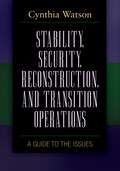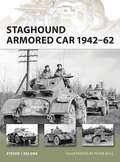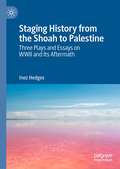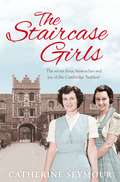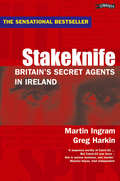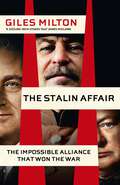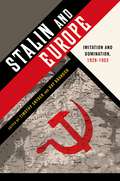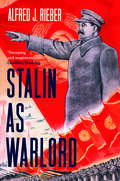- Table View
- List View
Stability, Security, Reconstruction, and Transition Operations: A Guide to the Issues (Praeger Security International)
by Cynthia A. WatsonThis book examines how the United States's extensive nation-building and stability operations will continue to evolve in the 21st century in the face of ever-growing budgetary concerns and constraints. Stability, Security, Reconstruction, and Transition Operations: A Guide to the Issues puts the people, places, and events crucial to nation-building and security operations through U.S. experiences under the microscope. This book focuses on the period after the Cold War, when U.S. operations proliferated, but also outlines the development of U.S. strategic decisions on nation-building and stability operations in a chronological fashion, providing documentation of these actions throughout American history. Original documents are provided and referenced to clarify concepts. With the increased attention on recent events in Iraq, Afghanistan, Egypt, and Libya, the United States's actions and policies of nation-building are now a key public policy discussion topic, and an understanding of these topics is critical for students, scholars, and general readers alike.
Stability, Security, Reconstruction, and Transition Operations: A Guide to the Issues (Praeger Security International)
by Cynthia A. WatsonThis book examines how the United States's extensive nation-building and stability operations will continue to evolve in the 21st century in the face of ever-growing budgetary concerns and constraints. Stability, Security, Reconstruction, and Transition Operations: A Guide to the Issues puts the people, places, and events crucial to nation-building and security operations through U.S. experiences under the microscope. This book focuses on the period after the Cold War, when U.S. operations proliferated, but also outlines the development of U.S. strategic decisions on nation-building and stability operations in a chronological fashion, providing documentation of these actions throughout American history. Original documents are provided and referenced to clarify concepts. With the increased attention on recent events in Iraq, Afghanistan, Egypt, and Libya, the United States's actions and policies of nation-building are now a key public policy discussion topic, and an understanding of these topics is critical for students, scholars, and general readers alike.
Stabilization and Human Security in UN Peace Operations (Routledge Research in the Law of Armed Conflict)
by Alexander GilderUN peace operations are increasingly asked to pursue stabilization mandates with lofty expectations of being able to stabilize conflict zones, achieve national reconciliation, and rebuild state legitimacy. This book investigates the relationship between UN stabilization mandates and the concept of ‘human security’. The book is divided into three parts. Part I outlines the emergence of stabilization and other trends in peacekeeping practice and outlines an analytical framework of human security. Part II applies the analytical framework to case studies of MINUSMA, MINUSCA, and UNMISS examining issues, such as human rights, empowerment, protection, and vulnerability. In Part III the book draws out several concerns that arise from stabilization mandates, including the militarisation of UN peace operations and the consequences under international humanitarian law, the risks of close cooperation with the host state and engagement in counter-terror activities, and the potential clash between peacebuilding activities and militarisation. The book will be a valuable resource for academics, policymakers and practitioners working on UN peacekeeping generally, and those specifically looking at stabilization, from the perspective of international relations, international law, peace and conflict studies, security studies and human rights.
Stabilization and Human Security in UN Peace Operations (Routledge Research in the Law of Armed Conflict)
by Alexander GilderUN peace operations are increasingly asked to pursue stabilization mandates with lofty expectations of being able to stabilize conflict zones, achieve national reconciliation, and rebuild state legitimacy. This book investigates the relationship between UN stabilization mandates and the concept of ‘human security’. The book is divided into three parts. Part I outlines the emergence of stabilization and other trends in peacekeeping practice and outlines an analytical framework of human security. Part II applies the analytical framework to case studies of MINUSMA, MINUSCA, and UNMISS examining issues, such as human rights, empowerment, protection, and vulnerability. In Part III the book draws out several concerns that arise from stabilization mandates, including the militarisation of UN peace operations and the consequences under international humanitarian law, the risks of close cooperation with the host state and engagement in counter-terror activities, and the potential clash between peacebuilding activities and militarisation. The book will be a valuable resource for academics, policymakers and practitioners working on UN peacekeeping generally, and those specifically looking at stabilization, from the perspective of international relations, international law, peace and conflict studies, security studies and human rights.
Staghound Armored Car 1942–62 (New Vanguard)
by Steven J. ZalogaThe Staghound was a unique World War II armored vehicle designed and manufactured in the US, but intended solely for the British army. Since its combat debut in Italy in 1943 until the end of the war it had performed particularly valuable service in a reconnaissance role where its speed and armor ensured that it was able to extricate itself from trouble as required without additional support. This book examines the development of this category of armored cars and offers a detailed analysis of the extensive combat use of the Staghound in British service as well as in the service of other Allied countries including Canada, New Zealand and Poland.
Staghound Armored Car 1942–62 (New Vanguard)
by Steven J. Zaloga Peter BullThe Staghound was a unique World War II armored vehicle designed and manufactured in the US, but intended solely for the British army. Since its combat debut in Italy in 1943 until the end of the war it had performed particularly valuable service in a reconnaissance role where its speed and armor ensured that it was able to extricate itself from trouble as required without additional support. This book examines the development of this category of armored cars and offers a detailed analysis of the extensive combat use of the Staghound in British service as well as in the service of other Allied countries including Canada, New Zealand and Poland.
Staging History from the Shoah to Palestine: Three Plays and Essays on WWII and Its Aftermath
by Inez HedgesThis book is a contribution to the emerging field of research-based performance, which seeks to gain a wider audience for issues that are crucial to our understanding of history and to informing our future actions. The book examines the role of theater in portraying the Shoah in France, the French Resistance, and the Israeli-Palestinian conflict. Each of the three chapters consists of an original dramatic work by the author and an accompanying critical essay.
Staging Holocaust Resistance (Palgrave Studies in Theatre and Performance History)
by Gene A. PlunkaPlunka argues that drama is the ideal art form to revitalize the collective memory of Holocaust resistance. This comparative drama study examines a variety of international plays - some quite well-known, others more obscure - that focus on collective or individual defiance of the Nazis.
The Staircase Girls: The secret lives, heartaches and joy of the Cambridge ‘bedders’
by Catherine SeymourJoyce leaned her black Triumph bicycle against a wall, and shivered in the foggy, early dawn light. Glancing up at the enormous wooden, carved gate, she hesitated. This was a secret world she was about to enter... For 16 year old Joyce, who lived in one of the poorest streets in Cambridge, the college building where she was about to enter represented privilege, wealth, a life she'd never live. As a bedder, Joyce would be working up and down one of the stone staircases, making the beds of the male students, sweeping floors, dusting desks. She never expected to also find herself mothering, chastising and sometimes even covering up for 'her boys'.The Staircase Girls takes us into the lives of Joyce and other bedders, like Nance, Maud, Rose and Audrey. They endured the Second World War and then had to contend with poverty, ill health and bereavement. They loved, lost and loved again. But their friendships gave them strength, and their work gave them happiness - and even a lasting connection with their charges, some of whom would go on to run the country. Revealing their untold stories for the first time, this is a vivid, poignant account of these remarkable women's lives.
Stakeknife: Britain's Secret Agents in Ireland (History Of Ireland And The Irish Diaspora Ser.)
by Greg Harkin Ian HurstBESTSELLER An explosive exposé of how British military intelligence really works, from the inside. The stories of two undercover agents -- Brian Nelson, who worked for the Force Research Unit (FRU), aiding loyalist terrorists and murderers in their bloody work; and the man known as Stakeknife, deputy head of the IRA's infamous ‘Nutting Squad', the internal security force which tortured and killed suspected informers.
Stalin: From the Caucasus to the Kremlin (Routledge Historical Biographies)
by Christopher ReadThis new biography of Stalin offers an accessible and up-to-date representation of one of the twentieth-century’s defining figures, as well as new insights, analysis and illumination to deepen our understanding of his actions, intentions and the nature of the power that he wielded. Christopher Read examines Stalin’s contribution to and impact on Russian and world events in the first half of the twentieth century. The biography brings together the avalanche of sources and scholarship which followed the collapse of the system Stalin constructed, including the often neglected writings and speeches of Stalin himself. In addition to a detailed narrative and analysis of Stalin’s rule, chapters also cover his early years and humble beginnings in a small town at a remote outpost of the Russian Empire, his role in the revolution, his relationships with Lenin, Trotsky and others in the 1920s, and his rise to become one of the most powerful figures in human history. The book closes with an account of Stalin’s afterlife and legacy, both in the immediate aftermath of his death and in the decades since. This concise account of Stalin’s life is the perfect introduction for students of modern Russian history.
Stalin: From the Caucasus to the Kremlin (Routledge Historical Biographies)
by Christopher ReadThis new biography of Stalin offers an accessible and up-to-date representation of one of the twentieth-century’s defining figures, as well as new insights, analysis and illumination to deepen our understanding of his actions, intentions and the nature of the power that he wielded. Christopher Read examines Stalin’s contribution to and impact on Russian and world events in the first half of the twentieth century. The biography brings together the avalanche of sources and scholarship which followed the collapse of the system Stalin constructed, including the often neglected writings and speeches of Stalin himself. In addition to a detailed narrative and analysis of Stalin’s rule, chapters also cover his early years and humble beginnings in a small town at a remote outpost of the Russian Empire, his role in the revolution, his relationships with Lenin, Trotsky and others in the 1920s, and his rise to become one of the most powerful figures in human history. The book closes with an account of Stalin’s afterlife and legacy, both in the immediate aftermath of his death and in the decades since. This concise account of Stalin’s life is the perfect introduction for students of modern Russian history.
The Stalin Affair: The Impossible Alliance that Won the War
by Giles Milton'Page-turning . . . a sizzling high-stakes tale' JAMES HOLLAND'This book might read like the screenplay of a gripping movie, yet every word is accurate and verified' ANDREW ROBERTS 'Giles Milton is a phenomenon' DAN SNOW'Another rollercoaster ride from Giles Milton. Endlessly surprising' ANTHONY HOROWITZFrom internationally bestselling historian Giles Milton comes the remarkable true story of the Allies' secret mission to wartime Moscow. In the summer of 1941, as Hitler invaded the Soviet Union, Stalin's forces faced a catastrophic defeat which would make the Allies' liberation of Europe virtually impossible. To avert this disaster, Britain and America mobilized an elite team of remarkable diplomats with the mission of keeping the Red Army in the war. Into to the heart of Stalin's Moscow Roosevelt sent Averell Harriman, the fourth richest man in America and his brilliant young daughter Kathy. Churchill dispatched the reckless but brilliant bon vivant Archie Clark Kerr - and occasionally himself - to negotiate with the Kremlin's wiliest operators. Together, this improbable group grappled with the ingenious, mercurial Stalin to make victory possible. But they also discovered that the Soviet dictator had a terrifying masterplan for the post-war world. Based on astonishing unpublished diaries, letters and secret reports, The Stalin Affair reveals troves of new material about the most unlikely coalition in history.
Stalin and Europe: Imitation and Domination, 1928-1953
by Timothy Snyder and Ray BrandonThe Soviet Union was the largest state in the twentieth-century world, but its repressive power and terrible ambition were most clearly on display in Europe. Under the leadership of Joseph Stalin, the Soviet Union transformed itself and then all of the European countries with which it came into contact. This volume considers each aspect of the encounter of Stalin with Europe: the attempt to create a kind of European state by accelerating the European model of industrial development in the USSR; mass murder in anticipation of a war against European powers; the actual contact with Europe's greatest power, Nazi Germany, first as ally and then as enemy; four years of war fought chiefly on Soviet territory and bringing untold millions of deaths, including much of the Holocaust; and finally the reestablishment of the Soviet system, not just in prewar territory of the USSR, but in Western Ukraine, Western Belarus, the Baltic States, Poland, Czechoslovakia, Romania, Hungary, Bulgaria, and East Germany.
Stalin and Europe: Imitation and Domination, 1928-1953
The Soviet Union was the largest state in the twentieth-century world, but its repressive power and terrible ambition were most clearly on display in Europe. Under the leadership of Joseph Stalin, the Soviet Union transformed itself and then all of the European countries with which it came into contact. This volume considers each aspect of the encounter of Stalin with Europe: the attempt to create a kind of European state by accelerating the European model of industrial development in the USSR; mass murder in anticipation of a war against European powers; the actual contact with Europe's greatest power, Nazi Germany, first as ally and then as enemy; four years of war fought chiefly on Soviet territory and bringing untold millions of deaths, including much of the Holocaust; and finally the reestablishment of the Soviet system, not just in prewar territory of the USSR, but in Western Ukraine, Western Belarus, the Baltic States, Poland, Czechoslovakia, Romania, Hungary, Bulgaria, and East Germany.
The Stalin and Molotov Lines: Soviet Western Defences 1928–41 (Fortress #77)
by Neil Short Adam HookIn the years following the Civil War, plans were drawn up to build a major set of fortifications along the Russian western border. Work began in 1926, leading to a front that stretched over 2,000km from the Baltic to the Black Sea. By the time of the outbreak of World War II, the defences of the Stalin Line, as it was known, were largely complete – but were also now too far behind the new Soviet border to be of any use in potential offensives. Stalin took steps to create a new defensive line inside Poland, which came to be known by the name of the Soviet Foreign Minister, Molotov. This book details the development of these lines, and the fighting that took place around them in 1941.
The Stalin and Molotov Lines: Soviet Western Defences 1928–41 (Fortress #77)
by Neil Short Mr Adam HookIn the years following the Civil War, plans were drawn up to build a major set of fortifications along the Russian western border. Work began in 1926, leading to a front that stretched over 2,000km from the Baltic to the Black Sea. By the time of the outbreak of World War II, the defences of the Stalin Line, as it was known, were largely complete – but were also now too far behind the new Soviet border to be of any use in potential offensives. Stalin took steps to create a new defensive line inside Poland, which came to be known by the name of the Soviet Foreign Minister, Molotov. This book details the development of these lines, and the fighting that took place around them in 1941.
Stalin and the Inevitable War, 1936-1941
by Silvio PonsThis is a study of the responses of the Soviet Union to the European crises which led to World War II. It is based on a substantial body of political and diplomatic documents that has become accessible to scholars since the opening up of former Soviet archives in 1992.
Stalin and the Inevitable War, 1936-1941
by Silvio PonsThis is a study of the responses of the Soviet Union to the European crises which led to World War II. It is based on a substantial body of political and diplomatic documents that has become accessible to scholars since the opening up of former Soviet archives in 1992.
Stalin and the Soviet-Finnish War, 1939-1940 (Soviet (Russian) Study of War)
by E. N. Kulkov Oleg Aleksandrovich Rzheshevskii Harold ShukmanThis is the verbatim record of a secret and hitherto unpublished meeting, held in the Kremlin in April 1940, devoted to a post mortem of the Finnish campaign.
Stalin and the Soviet-Finnish War, 1939-1940 (Soviet (Russian) Study of War)
by E. N. Kulkov O. A. RzheshevskyThis is the verbatim record of a secret and hitherto unpublished meeting, held in the Kremlin in April 1940, devoted to a post mortem of the Finnish campaign.
Stalin and War, 1918-1953: Patterns of Repression, Mobilization, and External Threat (Routledge Histories of Central and Eastern Europe)
by David R. ShearerStalin and War, 1918-1953 is the first book to examine the patterns of radicalized internal violence that characterized the Stalinist regime across the whole of the dictator’s rule, and it is one of the only works to connect patterns of internal violence to the dictator’s perceptions of war and foreign threat. Discussion focuses on the crisis years 1928-1932, 1936-1939, the Great Fatherland War, and the last war crisis period, 1947-1953. Violent repressions under Stalin were cyclical. They peaked and ebbed but, in each case, they were linked to Stalin’s expectation of war and invasion, to his perceived need for urgent internal mobilization, and to intense foreign policy activity. Stalin’s behavior in each of these perceived war crises followed a pattern established during the dictator's experience as a military commander in the Russian revolutionary wars, and especially during the Polish war in 1919 and 1920. Together, these chapters trace a consistent and interconnected logic of war and repression throughout Stalin’s political life. This book will be of interest to professional scholars of Soviet history, twentieth-century history, and World War II history, and it is approachable enough to be appreciated by general readers.
Stalin and War, 1918-1953: Patterns of Repression, Mobilization, and External Threat (Routledge Histories of Central and Eastern Europe)
by David R. ShearerStalin and War, 1918-1953 is the first book to examine the patterns of radicalized internal violence that characterized the Stalinist regime across the whole of the dictator’s rule, and it is one of the only works to connect patterns of internal violence to the dictator’s perceptions of war and foreign threat. Discussion focuses on the crisis years 1928-1932, 1936-1939, the Great Fatherland War, and the last war crisis period, 1947-1953. Violent repressions under Stalin were cyclical. They peaked and ebbed but, in each case, they were linked to Stalin’s expectation of war and invasion, to his perceived need for urgent internal mobilization, and to intense foreign policy activity. Stalin’s behavior in each of these perceived war crises followed a pattern established during the dictator's experience as a military commander in the Russian revolutionary wars, and especially during the Polish war in 1919 and 1920. Together, these chapters trace a consistent and interconnected logic of war and repression throughout Stalin’s political life. This book will be of interest to professional scholars of Soviet history, twentieth-century history, and World War II history, and it is approachable enough to be appreciated by general readers.
Stalin as Warlord (PDF)
by Alfred J. RieberAn authoritative account of Stalin as a wartime leader—showing how his paradoxical policies of mass mobilization and repression affected all aspects of Soviet society The Second World War was the defining moment in the history of the Soviet Union. With Stalin at the helm, it emerged victorious at a huge economic and human cost. But even before the fighting had ended, Stalin began to turn against the architects of success. In this original and comprehensive study, Alfred J. Rieber examines Stalin as a wartime leader, arguing that his policies were profoundly paradoxical. In preparation for the war, Stalin mobilized the whole of Soviet society in pursuit of his military goals and intensified the centralization of his power. Yet at the same time, his use of terror weakened the forces vital to the defense of the country. In his efforts to rebuild the country after the devastating losses and destruction, he suppressed groups that had contributed immeasurably to victory. His steady, ruthless leadership cultivated a legacy that was to burden the Soviet Union and Russia to the present day.
Stalin, Japan, and the Struggle for Supremacy over China, 1894–1945 (Routledge Open History)
by Hiroaki KuromiyaStalin was a master of deception, disinformation, and camouflage, by means of which he gained supremacy over China and defeated imperialism on Chinese soil. This book examines Stalin’s covert operations in his hunt for supremacy. By the late 1920s Britain had ceded place to Japan as Stalin’s main enemy in Asia. By seducing Japan deeply into China, Stalin successfully turned Japan’s aggression into a weapon of its own destruction. The book examines Stalin’s covert operations from the murder of the Manchurian warlord Zhang Zuolin in 1928 and the publication of the forged “Tanaka Memorial” in 1929, to Stalin’s hidden role in Japan’s invasion of Manchuria in 1931, the outbreak of all-out war between China and Japan in 1937, and Japan’s defeat in 1945. In the shadow of these and other events we find Stalin and his secret operatives, including many Chinese and Japanese collaborators, most notably Zhang Xueliang and Kōmoto Daisaku, the self-professed assassin of Zhang Zuolin. The book challenges accounts of the turbulent history of inter-war East Asia that have ignored or minimized Stalin’s presence and instead exposes and analyzes Stalin’s secret modus operandi, modernized as “hybrid war” in today’s Russia. The book is essential for students and specialists of Stalin, China, the Soviet Union, Japan, and East Asia.
